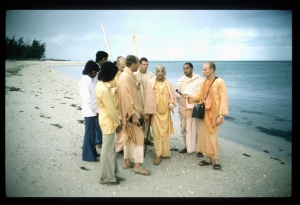CC Adi 4.9 (1975)

A.C. Bhaktivedanta Swami Prabhupada
TEXT 9
- kintu kṛṣṇera yei haya avatāra-kāla
- bhāra-haraṇa-kāla tāte ha-ila miśāla
SYNONYMS
kintu—but; kṛṣṇera—of Lord Kṛṣṇa; yei—that which; haya—is; avatāra—of incarnation; kāla—the time; bhāra-haraṇa—of taking away the burden; kāla—the time; tāte—in that; ha-ila—there was; miśāla—mixture.
TRANSLATION
But the time to lift the burden of the world mixed with the time for Lord Kṛṣṇa's incarnation.
PURPORT
We have information from the Bhagavad-gītā that the Lord appears at particular intervals to adjust a time-worn spiritual culture. Lord Śrī Kṛṣṇa appeared at the end of Dvāpara-yuga to regenerate the spiritual culture of human society and also to manifest His transcendental pastimes. Viṣṇu is the authorized Lord who maintains the created cosmos, and He is also the principal Deity who makes adjustments for improper administration in the cosmic creation. Śrī Kṛṣṇa is the primeval Lord, and He appears not to make such administrative adjustments but only to exhibit His transcendental pastimes and thus attract the fallen souls back home, back to Godhead.
However, the time for administrative rectification and the time for Lord Śrī Kṛṣṇa's appearance coincided at the end of the last Dvāpara-yuga. Therefore when Śrī Kṛṣṇa appeared, Viṣṇu, the Lord of maintenance, also merged in Him because all the plenary portions and parts of the absolute Personality of Godhead merge in Him during His appearance.